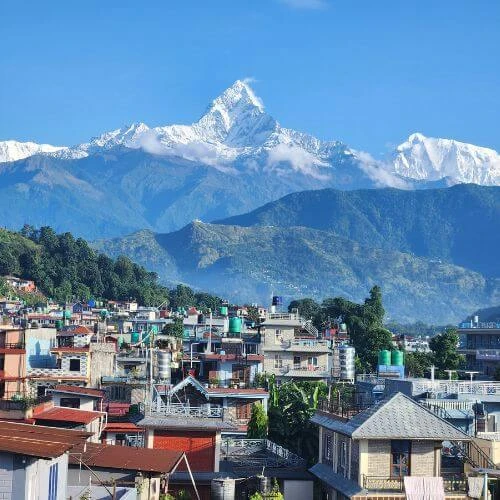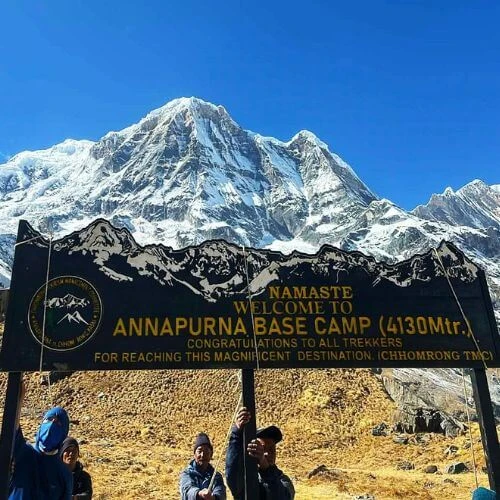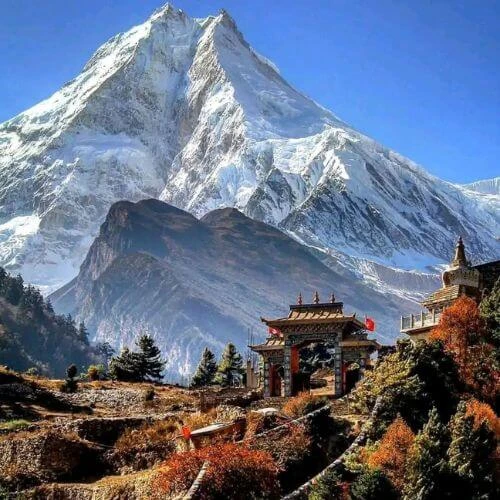History and Myth Surrounding Indra Jatra and Kumari Jatra in Nepal
The myth of Indra Jatra tells the story of lord Indra, the king of heaven and god of rain and thunderstorms, who came to Kathmandu in human form to gather a special white flower called parijat for his mother Dagini. While he was picking the flowers, the locals, mistaking him for a thief, bound him. Worried about her son's disappearance, Dagini came looking for her son. Afterward, realizing that they had captured a god, the city's people released Indra and begged his forgiveness. Indra then promised them that he would send rain for the city and take the spirits of those who had died in the past year to heaven. During the festivities of the Indra Jatra festival, people organize dances to honor and please the gods.
As Indra Jatra developed, it became part of the celebration of another important tradition—the Kumari Jatra. The custom began in the 17th century during the regime of King Jaya Prakash Malla, the last Newar king of the Malla dynasty. According to historical evidence, this practice started around 1708 AD, though some scholars believe Kumari worship may have existed earlier, possibly back to the 6th century.

One of the well-known stories concerning the origins of Kumari Jatra involves King Jaya Prakash Malla and the goddess Taleju, protecting the deities of the Malla kings. According to the legend, the goddess Taleju visited the king every night in human form, played dice, and discussed vital political matters. Such meetings were kept secret, but one night the queen, suspecting these visits, decided to spy on them.
When Taleju discovered her privacy invaded, she was enraged and stopped visiting the king. The king, hence worried that his kingdom could no longer be safe without the protection of the goddess, thus asked for the help of the priests and astrologers. They advised him to select a young girl from the Shakya clan or Bajracharya clan, Newari Buddhist families, to represent the goddess as a living embodiment.
Following their advice, the king initiated the tradition of selecting the Kumari, or the living goddess, so that divine protection would continue to extend to the kingdom.
Today, Kumari Jatra also known as Kumari Indra Jatra is one of the most important events of the Indra Jatra festival. The sight of this young Kumari going around Kathmandu in her gorgeously attired chariot acts as a reminder of the rich cultural heritage of Nepal with myth, history, and tradition.
Key events and festivities of Indra Jatra
Kumari Jatra
Kumari Jatra is a crucial and joyful event in the Indra Jatra festival, which King Jayaprakash Malla established in the 18th century. This Newar festival in Nepal centers around a young girl called the Kumari, who is worshiped as a living goddess in Nepal. People regard her as the incarnation of the goddess Taleju Bhawani, who is believed to guard the city and bring fortune to its inhabitants. To become a Kumari, a girl must undergo a rigorous selection process. She needs to come from the Newar Shakya caste, be a virgin, and possess qualities like patience and strength, as she represents a goddess.
After her selection, the Kumari rides through Kathmandu city in a colorful chariot during the Kumari Jatra as part of the Indra Jatra festival. Music, dancers, and a large crowd accompany her. The procession, often called the ‘worship,’ is the festival's most significant event, drawing many faithful who come to receive blessings from the living goddess. This religious procession and festival offer a chance to appreciate the religious and cultural heritage of the Kathmandu Valley. The Kumari’s appearance during Indra Jatra symbolizes both protection for the community and prosperity for its members.

Pulu Kisi
Pulu Kisi brings a lively and exciting celebration of the Indra Jatra festival in Kathmandu. The residents of Kilagal Tole perform this lively dance, with Pulu Kisi believed to be the carrier of Lord Indra himself. During the festival, Pulu Kisi parades through Kathmandu’s ancient streets, symbolizing the search for the imprisoned Lord Indra.
As Pulu Kisi walks in the middle of the streets the festival is filled with joy and people are laughing out loud. The masked creature quickly gets everyone’s attention with its trick. It runs through the crowd, bumping into people and swinging its tail in a dramatic way, adding a fun and humorous touch to the celebration.
A music band and a torch carrier come forward along with Pulu Kisi, creating a lot of lively activity with lights and music. This is one of the biggest parts of Indra Jatra, a festival that symbolizes Nepali tradition and its positive atmosphere, which unites people.
Majipa Lakhey
Majpa Lakhey is an appealing and significant character in the Indra Jatra festival, a festival in the Kathmandu Valley of Nepal. The demon-like character, famous for its dramatic appearance and intensive dance, is rooted in the ancient beliefs of the Newar people, the indigenous population of the valley.
At the festival, the dancer wears a large, fierce red mask with bulging eyes and sharp teeth. The mask is paired with a vibrant red bodysuit, decorated with intricate embroidery and small, shiny mirrors that sparkle as the dancer moves.
Despite being portrayed as a scary character, Majpa Lakhey is generally perceived as a guardian spirit. The first part of his name ‘Majpa’ stands for ‘peace’ in the Newari language while ‘Lakhey’ is Newari for ‘demon’. While jumping, turning, and dancing, people think his actions drive away demons and bless the town and all its residents.
In addition to Majpa Lakhey, there are other cultural mask dances performed during the Indra Jatra festival, such as Pulukisi, Dagin procession, Sawa Bhakku, Māhākāli Pyakhan, and Devi Pyakhan. The foregoing dances are not just carried out to entertain people, but they are socio-cultural and or religious in context. They are perceived to be bringing good luck, chasing away evil, and as a sign of respect to the gods. The masks used in these dances are chosen accurately and are made by expert craftsmen.

Mata Biye
Mata Biye is an important ritual during the Indra Jatra festival in Nepal, especially on Kwaneyā, the first day of the chariot procession. The term "Mata Biye" means "offering butter lamps" in Newari. During this ritual, people honor their deceased family members and show respect to their living relatives and friends.
The ceremony starts in the evening around 6 pm, when the chariot procession begins. People light small butter lamps and place them along the chariot's path to pay tribute to family members who passed away in the previous year. These lamps symbolically guide the spirits of the deceased and keep their memory alive during the festival. The soft glow of the lamps creates a peaceful and meaningful atmosphere along the procession route.
Mata Biye is also a time for people to show love and care for their living relatives and friends. As they walk along the path, they offer butter lamps to those they meet, making it a moment of connection and respect.
Bhairav Mask Display
The Bhairav mask display is a key part of the Indra Jatra festival in Nepal. During this time, a large, colorful wooden mask of Bhairav, a fierce form of the Hindu god Shiva, is shown to the public.
Normally, the mask is kept hidden inside Hanuman Dhoka, a temple in Kathmandu. But during Indra Jatra, it's brought out and displayed in a special window of the temple. This only happens once a year, making it a rare and significant event.

When the mask is revealed, people gather to see it. Many believe that looking at the Bhairav mask brings good luck and protects them from harm. As part of the tradition, Aila ( Newari beer) flows from the mask’s mouth, and people try to catch and drink some, seeing it as a blessing.
This mask display is just one highlight of Indra Jatra, which is filled with various religious ceremonies, dances, and celebrations throughout Kathmandu Valley.
Rising of Lingo Pole
The raising of the Lingo pole is also one of the significant celebrations of the Indra Jatra festival celebrated in Kathmandu, Nepal. The Lingo is a tree-like structure approximately 36 feet in height which is made of a tree trunk and on which are hung flags and banners. The famous huge festival begins with the pole-raising ceremony which is held at Kathmandu Durbar Square where people come in large numbers to watch the ceremony and actively participate in it. A large number of people use ropes, labor, and conventional ways to lift the gigantic pole and fix it in the required area.
As the Lingo surfaces, prayers and hymns take over the air, making the environment lively as well as provocative. The pole symbolizes the flagstaff of Indra, the god of rain and king of heaven according to Hindu mythology. Its raising announces the beginning of the festival and becomes a part of the show.
Throughout the 8 days, the structure of the Lingo dominates Durbar Square, the place where people come to carry out ceremonies and sacrifices. From dance and music, the square turns to be central to traditional dancing and music. The Lingo is ceremonially let down at the end of the festival therefore marking the end of the celebration in the community.
How is Indra Jatra celebrated in Kathmandu, Bhaktapur, and Lalitpur?
Indra Jatra is celebrated differently in Kathmandu, Bhaktapur, and Lalitpur. In Kathmandu, the festival starts with the erection of a wooden pole known as the Yosin at the palace of Hanuman Dhoka. The parade includes a chariot rally, during which Kumari, the current living goddess is taken through the streets. Large Bhairav masks are displayed in the city, Dagin dances are performed, and legends depict stories such as the search for Indra by his mother. Processions of chariots of Ganesh, Bhairav, and Kumari are taken around the city and people offer prayers and perform puja. The festival is concluded by the process of pulling down the Yosin pole and the communal feasting.

The Indra Jatra festival in Bhaktapur is also known as “Yenyā”, bringing much joy within the community. Yosin or Yasin, a wooden pole similar to the one in Kathmandu’s Basantapur Durbar Square is erected at Taumadhi Square to mark the initiation of the festival. The remarkable aspect of the festival in Bhaktapur is the fact that it celebrates local deities and practices every day. Among them, the Bhairav mask parade holds the most significance. This God’s mask specifically belongs to Lord Shiva, and each year it is taken from the temple through the city while playing traditional instruments and singing. There are also chariot processes for the local gods and Goddesses, such as Ganesha and Kumar, who are taken through the city on narrow roads. Although not as large as in Kathmandu these processions are in fact an important part of Bhaktapur culture. Also, the Deo Pyākhan, or ‘God Dance,’ is equally elaborated as part of the proposed ceremonies. The dancers move around with masks depicting various gods and dance as they represent various myths and shower blessings on the audience.
Indra Jatra in Lalitpur is celebrated in different ways by organizing its specific style. The festival celebrated here seems to have a closer relation with the local culture and gods and goddesses than Kathmandu. Of the main events one of the most significant is the showing of the Bhairav mask at Pater Durbar Square. While Kumari Ghar in Kathmandu has a living goddess Kumari, who comes out to the public; the festival of Lalitpur focuses on worshiping Bhairav. The festivities include a number of minor and localized chariot processions that celebrate local gods and goddesses with Newari music and dance at intervals. One interesting feature of the festival in Lalitpur is the tradition of giving threads to the god Indra. The people also attach ribbons to temples and other related structures within the city signifying ropes used to capture Indra in the festival’s legend. They also perform some masked dances, which are quite similar to the dances done in Kathmandu.
Significance of Celebrating Indra Jatra
Indra Jatra is one of the biggest religious festivals in Nepal, especially in the Kathmandu valley. It is cultural and religious practices that assemble people with a common culture for celebration and ensure local practices are preserved. It is held in September for eight days.
The festival is crucial since it celebrates Indra – the Hindu deity of rain and harvest. Due to the significance of farming in the lives of people in Nepal, they celebrate Indra to demonstrate how they depend on favorable weather for their crops. The festival is a call to thank him for the rain and to request more rain for the following year.
Another significant component of Indra Jatra is the participation of the living goddess known as Kumari. During the festival, Kumari, a young girl considered incarnation of the goddess Taleju, is drawn with a chariot. This is perhaps the only time when many Nepalis would be able to get a glimpse of her and seek her blessings which is a very unique occasion.
This festival also plays its part in maintaining Nepal’s cultural heritage. This is common group performances which are normally associated with dancing, singing, and performances of other cultural events. These customs are practiced by people every year to maintain the identity of culture and pass it on to the younger generation.

It also unites groups of people as it is a festival typically held in different places. There is no discrimination between castes, sexes, and ages during Indra Jatra, they eat together and enjoy the festivity. This way brings a feeling of unity and solidarity to the community of Kathmandu and the nearby location.
As the social changes are happening on a global scale, Indra Jatra makes people aware of the history and traditions of Nepal. It also assists them to stay connected to their culture, feel proud to be associated with their culture, and helping in the transmission of culture to the next generation.
Tips for Attending Indra Jatra in Kathmandu, Bhaktapur, and Lalitpur
Kathmandu
- For the best views of Indra Jatra, head to Durbar Square for the main performances, Hanuman Dhoka for the pole-raising ceremony, and Asan or Indra Chowk to see the chariot processions up close.
- The living goddess Kumari makes a rare public appearance during Indra Jatra. Her chariot procession usually starts around 3 PM on the fourth day of the festival. Get to Hanuman Dhoka Palace early to secure a good spot, as large crowds gather for this special event.
- Learning about the festival’s history before you go can make the experience even more enjoyable.
- Don’t miss the masked dances, which are a key part of the celebrations.
- Kathmandu Durbar Square is open to tourists during Indra Jatra, making it a perfect place to take photos of the festivities.
Bhaktapur
- For the best views of Indra Jatra in Bhaktapur, go to Taumadhi Square to watch the main performances and the Bhairab chariot procession.
- Don’t miss the unique Pulukisi dance, a lively elephant dance that usually happens in the evening.
- Watch for the Dey Payo ceremony, a torch-lit procession that takes place on the fourth day of Bhaktapur’s Indra Jatra.
- Taumadhi Square stays open to tourists during the festival, so it’s a great chance to capture photos of the chariots and celebrations.
- Learn about the local deities honored during Bhaktapur’s version of the festival, which focuses more on the city’s gods.
Lalitpur (Patan)
- For the best views of Indra Jatra in Lalitpur, visit Durbar Square for the main events. It’s less crowded than Kathmandu, giving you a more personal experience.
- Attend the Kumari Puja at Patan's Kumari Ghar, which is different from Kathmandu’s Kumari ceremony.
- Visit the Golden Temple (Hiranya Varna Mahavihar) to see a unique mix of Buddhist rituals alongside the Hindu celebrations.
- Watch the local chariot processions of Bhairav and other gods, accompanied by traditional Newari music and dancing.
- Join in the community feast (Bhoj), where locals often invite visitors to share food and enjoy the festival together.
Learn More About Kathmandu City Here
Kathmandu City Tour | Capital City of Nepal, Kathmandu | Photography in Kathmandu | Hiking Destinations in Kathmandu
Frequently asked questions about the Indra Jatra Festival in Nepal
When is Indra Jatra in 2025 (Nepali date 2082)?
This year Indra Jatra is on September 6th which is Bhadra 21 in the Nepali calendar. But the celebration begins on the 15th of Bhadra.
How long does Indra Jatra Last?
Indra Jatra festival lasts for eight days where major worship, dance, and cultural parades are performed in Kathmandu valley and other major cities of Nepal.
Are tourists allowed to participate in the Indra Jatra celebration?
Yes, tourists are welcome and recommended to join the Indra Jatra festival, during which they can watch and participate in cultural events and rituals along with Nepali people.
How Long has Indra Jatra Been celebrated in Kathmandu?
Indra Jatra festival has been celebrated in Kathmandu for more than a thousand years and has its history from the 10th century.
Who started the Indra Jatra Festival?
King Gunakamadeva began the Indra Jatra festival to celebrate the establishment of Kathmandu Valley and Lord Indra, the god of rain or harvest.



 based on 3 reviews
based on 3 reviews








